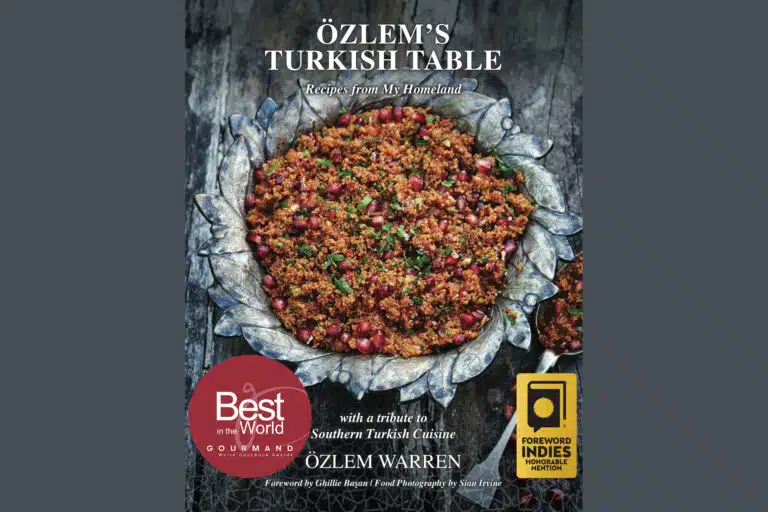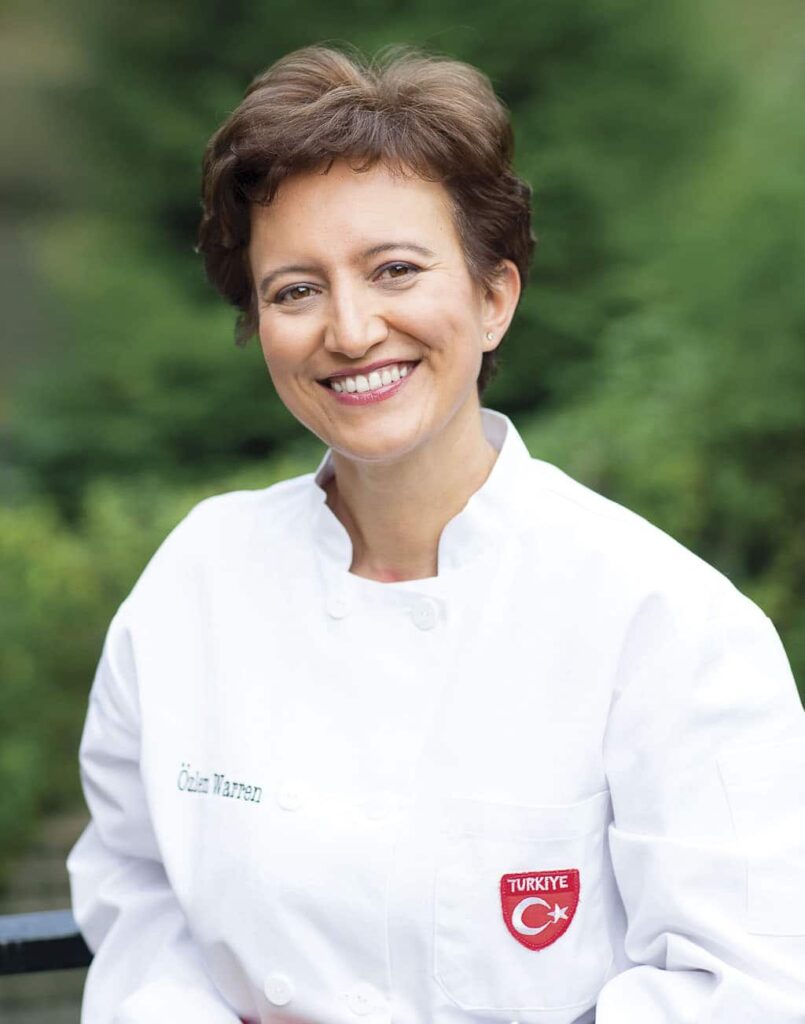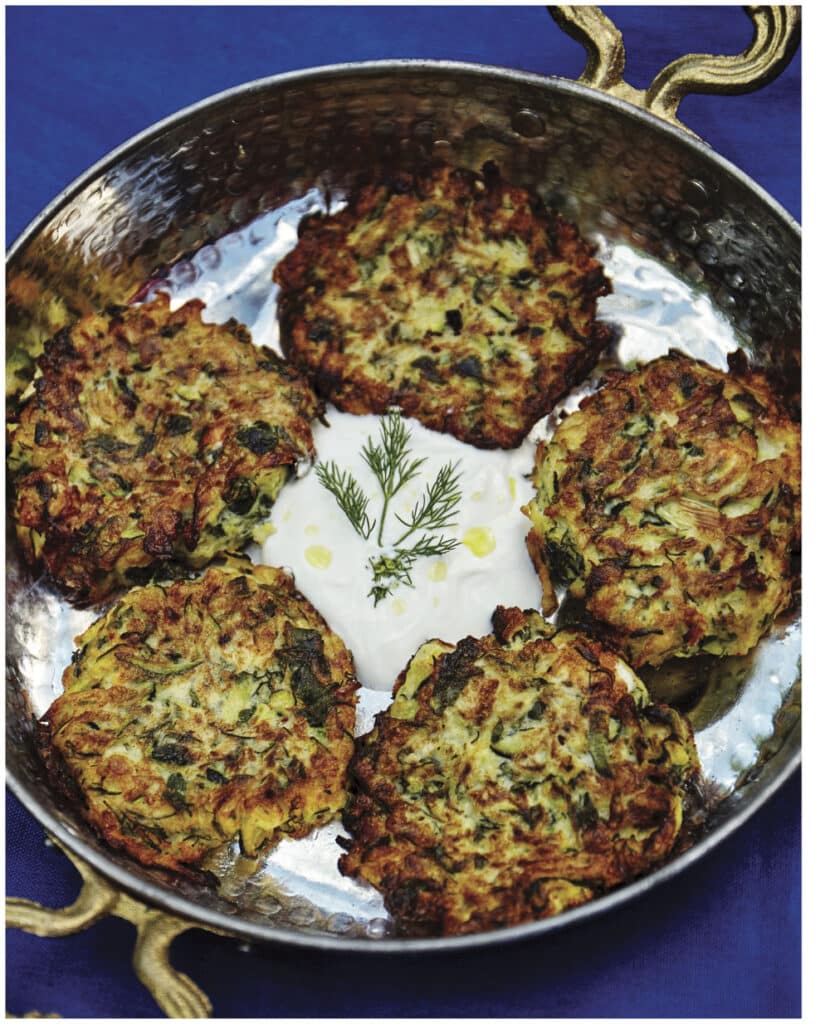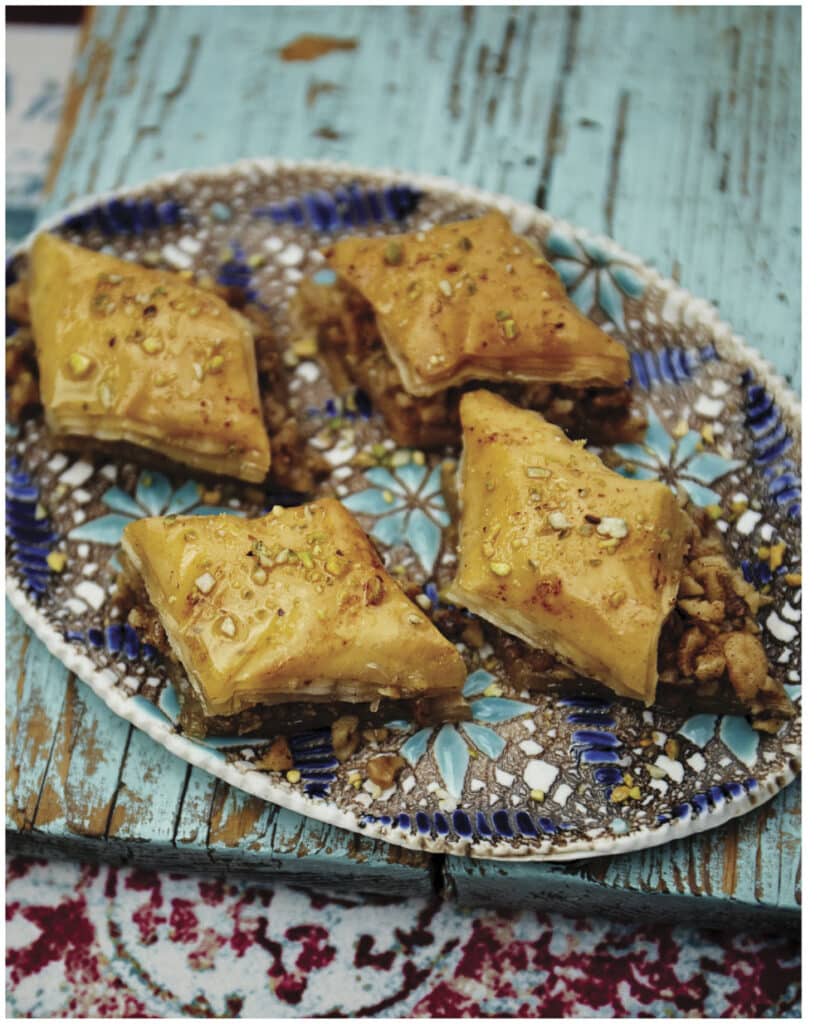RECIPE BOOK
Özlem’s Turkish Table

WORDS: Ozlem Warren PHOTOGRAPHY Supplied
There are few places in the world where the cuisine is so rich and diverse, where the people are so friendly and keen to share, and where the hospitality shines like a bright beacon.
With her nostalgic stories of family feasts and growing up in the Antakya region – the land of pistachios, bulgur, ÖZLEM WARREN red pepper sauce, hot red pepper, and pomegranate molasses Özlem has managed to bring the culinary culture alive.
Historically and culturally, Turkey fascinating country of extraordinarily beautiful landscapes. Dountitu seas and rich agriculture which contribute to the fresh, healthy, vivid cuisine captured in this book with its refreshing emphasis on the cooking of the southern region, the Güney cuisine With its geographical proximity to Syria and the Arab influence, the region is a melting pot of religious faiths, languages and culinary cultures culminating in a uniquely robust and spicy cuisine.
‘Greet a Turk and you will eat’ is a saying that is demonstrated by Ozlem every day as she shares her passion for her Turkish cuisine in her classes and talks, in her blogs, and now in this precious book, Özlem’s Turkish Table in which she proudly puts the cooking of her southern homeland firmly on the culinary map.
Foreword written by Ghillie Basan – writer, broadcaster and food anthropologist, with highly-acclaimed books on the cuisines of Turkish, Middle East and South-east Asia.
Özlem’s Turkish Table Recipes
Courgette/zucchini fritters with feta and dill
Serves 4
Ingredients
200g/7oz Turkish white cheese,
bevaz peynir or feta cheese,
crumbled
I medium onion, grated
or finely chopped
3 spring onions/scallions,
finely chopped
3 garlic cloves, finely chopped
I small bunch dill, finely chopped
Handful of flat leaf (Italian) parsley,
finely chopped
3 eggs, beaten
60ml/4 tablespoons all-purpose
plain flour
5ml/1 teaspoon Turkish red pepper
flakes or chili flakes (optional)
Salt and ground black pepper
to taste
Canola oil (or sunflower oil)
for shallow frying
For garlic yoghurt:
I clove of garlic, crushed with salt
and finely chopped
240ml/881 oz plain yoghurt
Method
Place the grated courgette/zucchini in a colander, sprinkle with a little salt and leave to drain for 15 minutes. Using a tea towel, really squeeze out any excess juice from the courgette/zucchini and put in a large bowl. This is a crucial step as otherwise the moisture would make the fritters soggy.
Transfer the flour to the large bowl and stir in the beaten eggs. Crumble the Turkish white cheese, beyaz peynir or feta cheese and combine in the large bowl. Add the remaining ingredients, season with salt and ground black pepper and combine well into a batter (take care not to add salt if your cheese is already salty).
In a frying pan, heat enough oil to shallow fry. Using a tablespoon, drop the batter mix into the hot oil spoonful by spoonful, leaving space between each one. Fry over a medium heat for about 3 minutes each side until both sides are golden brown. Remove with a straining spoon and drain on an absorbent kitchen paper towel.
For garlic yoghurt, crush a garlic clove with salt and finely chop. Combine the plain yoghurt and garlic and beat until smooth. Add salt to taste.
Serve at room temperature or cold with garlic yoghurt at the side. Afivet Olsun.
These fritters, kabak mücveri are a great way to enjoy courgettes/zucchinis. It is important to squeeze out the excess juice from the grated courgettes in this recipe otherwise the fritters will turn out wet and soggy. Serve these light, crispy vegetarian fritters with garlic yoghurt as an appetizer or with a green salad and crusty bread as a light lunch. Smaller bitesize fritters also make an excellent finger food for entertaining.
If you are after a lighter flavour, you can bake the spread, like my mother does, in a greased baking dish at 180°C/350°F/Gas Mark 4 for about 35- 40 minutes. Once cool, you can then cut in squares and serve.
Baklava With Pistachios And Walnuts
Serves 12
Ingredients
2300/80z melted unsalted butter
440g/1lb (2 packs of) filo pastry
Shppts – total 74 shepts – thawed
400g/14oz walnuts, finely chopped
teaspoons inamon
For the syrup:
450g/Ilb sugar
420ml/14f1 oz water
Juice of I lemon
12inx7in/30cmx 19cm baking dish
to bake
To serve:
Ground pistachio nuts to sprinkle
Method
Preheat oven to 160°C/325°F/Gas Mark 3
Make the syrup first. Put the sugar into a heavy pan, pour in water and bring to the boil, stirring all the time. When the sugar is dissolved, lower the heat and stir in the lemon juice. Then simmer for about 15 minutes. until the syrup thickens. Leave to cool in the pan.
Melt the butter in a small pan and then brush a little over the bottom and sides of the baking pan.
Place two sheets of filo pastry in the bottom of the greased pan and brush it with melted butter (trim from the edges to fit, if needed). Continue until you have used 12 filo sheets, brushing every two sheets with butter. Ease the sheets into the corners and trim the edges if they flop over the rim of the pan.
Spread the walnuts over the twelfth buttered sheet and sprinkle with the cinnamon, and then continue as before with the remaining filo sheets. Brush the top one as well, then, using a sharp knife cut diagonal parallel lines right through all the layers to the bottom to form small diamond shapes.
Bake the baklava in the preheated oven for about 45 minutes or until the top is golden – if it is still pale, increase the temperature for a few minutes.
When the baklava is ready, remove it from the oven and slowly pour the cooled syrup over the piping hot pastry. Return to the oven for 2-3 minutes to soak up the syrup, then take it out and leave to cool.
Once the baklava is cool, gently lift the diamond shaped pieces out of the pan and arrange them onto a serving plate. Serve baklava pieces with ground pistachios over them, always at room temperature.
Note: Baklava should never be stored in the refrigerator, as the fat congeals, pastry absorbs in the moisture and it becomes soggy.
Baklava is a legacy of the Ottoman Empire and was perfected by the pastry chefs in the Topkapt Palace. Baklava is enjoyed as a mid-morning sweet snack with Turkish coffee or tea, as a dessert after lunch or dinner. Any time of day works for a good piece of baklava! The real thing shouldn’t be overly sweet and heavy, but light enough to tempt you to eat a small plateful of these flaky delicacies.
Like this fragrant and lighter version than the commercially available baklavas. Filo pastry sheets work well for making homemade baklava and it’s easier than you think. This recipe is adapted from Ghillie Basan’s.
The Complete Book of Turkish Cooking.
Ozlem’s Turkish Table Recipes from My Homeland by Ozlem Warren has over 90 authentic, delicious, easy to make Turkish recipes, along with stunning photography and stories from her homeland available online from Booktopia. 25% of all signed book sales sold through gbpublishing.co.uk goes to the Turkey earthquake relief.











